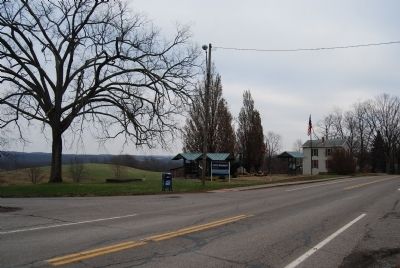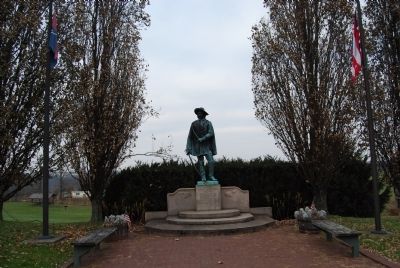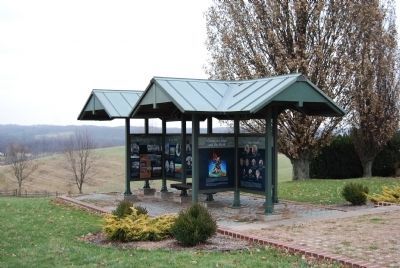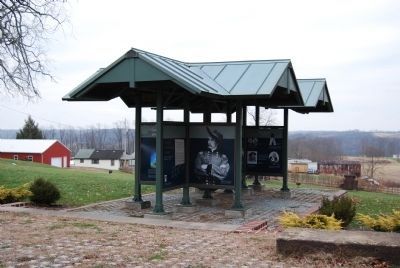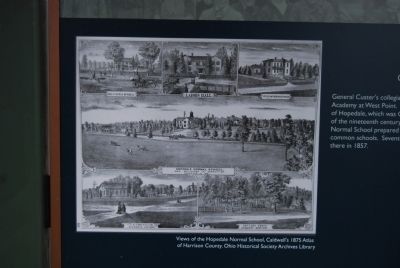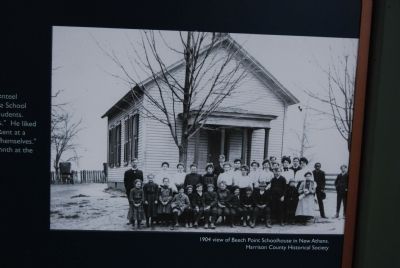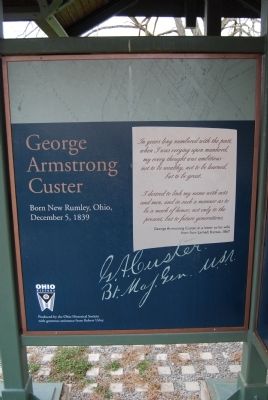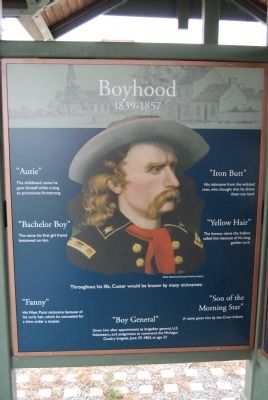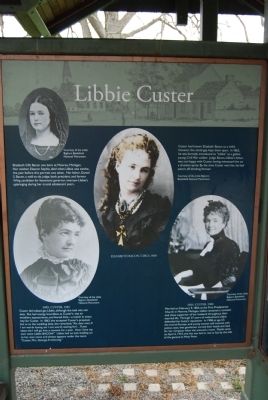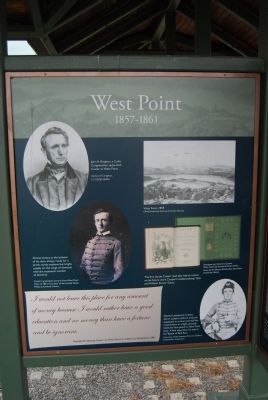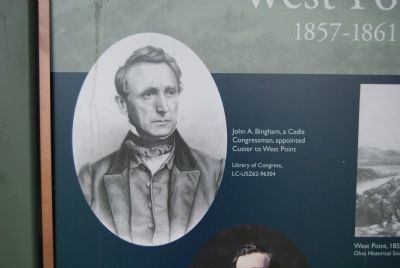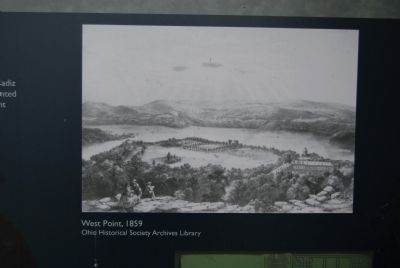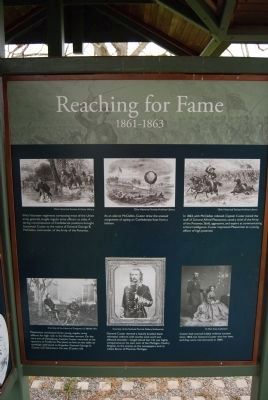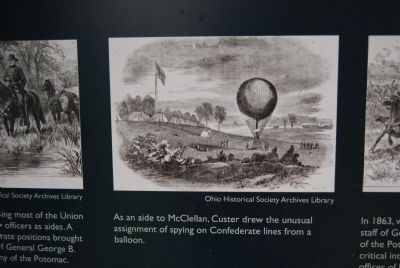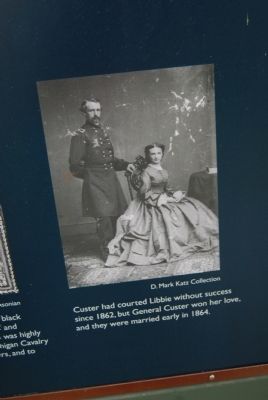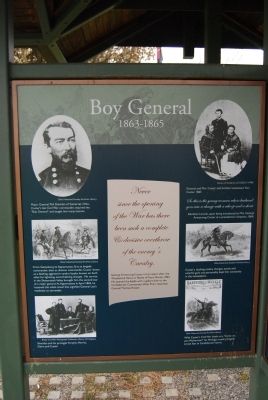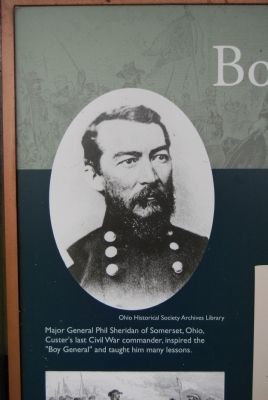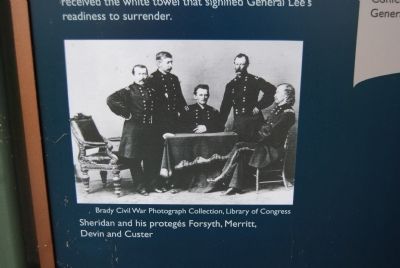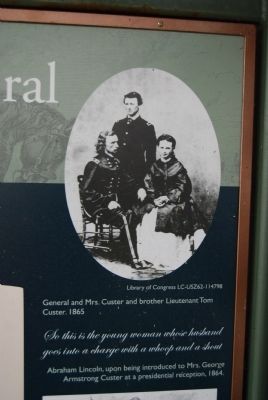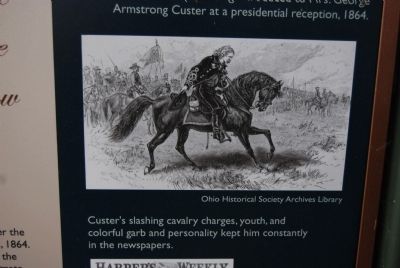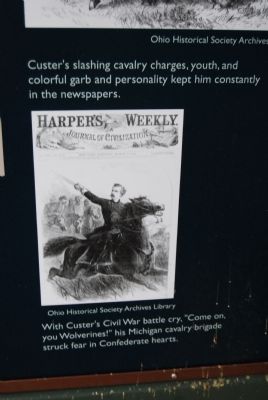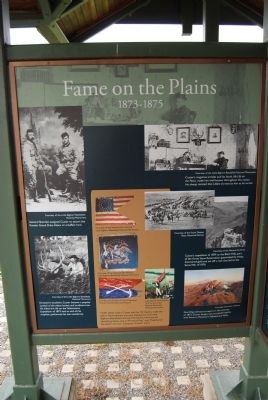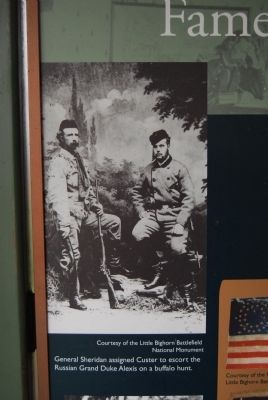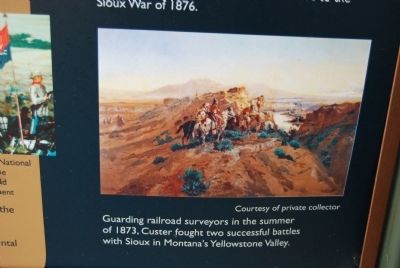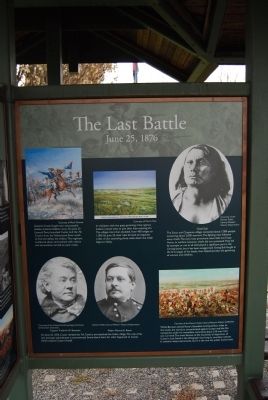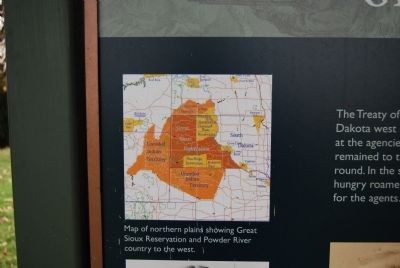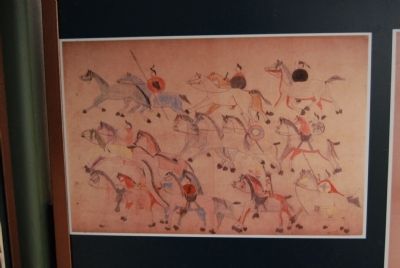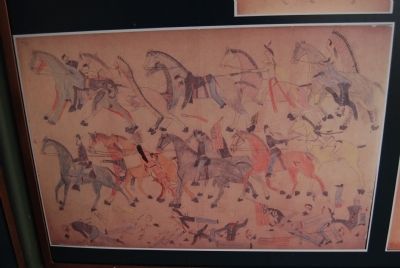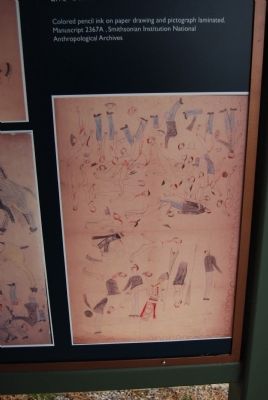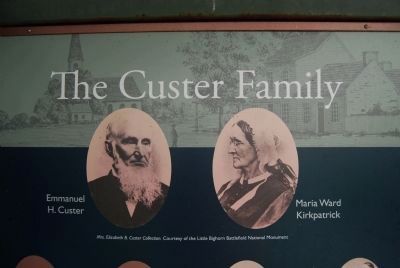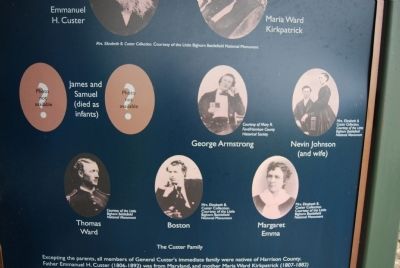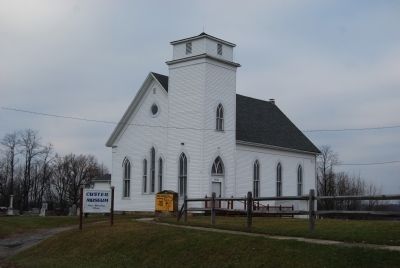New Rumley in Harrison County, Ohio — The American Midwest (Great Lakes)
Custer Monument Historic Site
Topics. This historical marker is listed in these topic lists: Native Americans • War, US Civil.
Location. 40° 24.203′ N, 81° 2.021′ W. Marker is in New Rumley, Ohio, in Harrison County. Marker can be reached from the intersection of Rumley Road (Ohio Route 646) and County Route 137, on the right when traveling west. Touch for map. Marker is in this post office area: New Rumley OH 43984, United States of America. Touch for directions.
Other nearby markers. At least 8 other markers are within 8 miles of this marker, measured as the crow flies. New Rumley (approx. 0.3 miles away); a different marker also named New Rumley (approx. 0.6 miles away); Scio, Ohio (approx. 2.8 miles away); The Perrysville Methodist Episcopal Church (approx. 5.4 miles away); Abraham Lincoln at Cadiz Junction (approx. 6.2 miles away); For Your Todays They Gave Their Tomorrow (approx. 7˝ miles away); World War II Honor Roll (approx. 7˝ miles away); Heavy MG08 Machine Guns (approx. 7˝ miles away). Touch for a list and map of all markers in New Rumley.
Also see . . .
1. Custer Monument Historic Site. Ohio History Connection website entry (Submitted on December 22, 2014, by Mike Wintermantel of Pittsburgh, Pennsylvania.)
2. George Armstrong Custer and Elizabeth "Libby" Bacon Custer gravesite at West Point NY. Find A Grave website entry (Submitted on December 22, 2014, by Mike Wintermantel of Pittsburgh, Pennsylvania.)
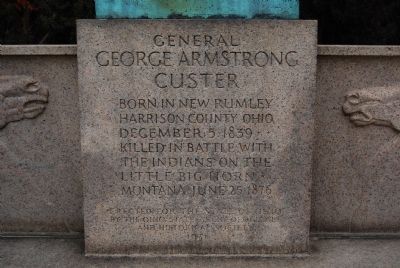
Photographed By Mike Wintermantel, December 21, 2014
3. Custer Statue Inscription
General George Armstrong Custer
Born in New Rumley
Harrison County, Ohio
December 5, 1839
Killed in battle with the Indians on the Little Big Horn Montana June 25, 1876
Erected for the State of Ohio by the Ohio State Archaological and Historical Society
1931
Born in New Rumley
Harrison County, Ohio
December 5, 1839
Killed in battle with the Indians on the Little Big Horn Montana June 25, 1876
Erected for the State of Ohio by the Ohio State Archaological and Historical Society
1931
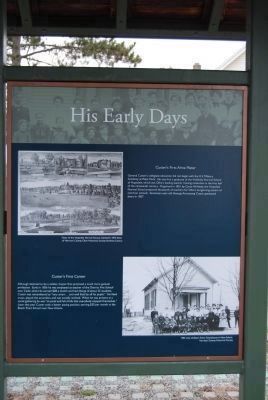
Photographed By Mike Wintermantel, December 21, 2014
6. George Armstrong Custer - His Early Days
Top Photo
Custer's First Alma Mater
General Custer's collegiate education did not begin with the U.S. Military Academy at West Point. He was first a graduate of the McNeely Normal School of Hopedale, which was Ohio's leading teacher training institution in the first half of the nineteenth century. Organized in 1851 by Cyrus McNeely, the Hopedale Normal School prepared thousands of teachers for Ohio's burgeoning system of common schools. Seventeen-year-old George Armstrong Custer graduated from there in 1857.
Bottom Photo
Custer's First Career
Although destined to be a soldier, Custer first practiced a more genteel profession. Early in 1856 he was employed as a teacher of the District Five School near Cadiz where he earned $28 a month and had charge of about 25 students. Custer was remembered as "very smart...and well liked by all his pupils." He liked music, played the accordian, and was socially inclined. When he was present at a social gathering he was "so jovial and full of life that everybody enjoyed themselves." Later that year Custer took a better paying position, earning $30 per month at the Beech Point School near New Athens.
Custer's First Alma Mater
General Custer's collegiate education did not begin with the U.S. Military Academy at West Point. He was first a graduate of the McNeely Normal School of Hopedale, which was Ohio's leading teacher training institution in the first half of the nineteenth century. Organized in 1851 by Cyrus McNeely, the Hopedale Normal School prepared thousands of teachers for Ohio's burgeoning system of common schools. Seventeen-year-old George Armstrong Custer graduated from there in 1857.
Bottom Photo
Custer's First Career
Although destined to be a soldier, Custer first practiced a more genteel profession. Early in 1856 he was employed as a teacher of the District Five School near Cadiz where he earned $28 a month and had charge of about 25 students. Custer was remembered as "very smart...and well liked by all his pupils." He liked music, played the accordian, and was socially inclined. When he was present at a social gathering he was "so jovial and full of life that everybody enjoyed themselves." Later that year Custer took a better paying position, earning $30 per month at the Beech Point School near New Athens.
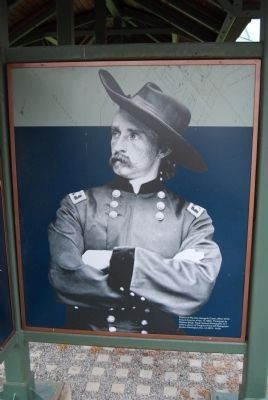
Photographed By Mike Wintermantel, December 21, 2014
10. Custer Monument - Interpretive Display
Panel 2
Portrait of Maj. Gen. George A. Custer, officer of the Federal Army (as of Apr. 15, 1865). Photograph by Matthew Brady, Brady National Photographic Art Gallery, Library of Congress Prints and Photographs Division Washington, D.C., LC-B813-1613B
Portrait of Maj. Gen. George A. Custer, officer of the Federal Army (as of Apr. 15, 1865). Photograph by Matthew Brady, Brady National Photographic Art Gallery, Library of Congress Prints and Photographs Division Washington, D.C., LC-B813-1613B
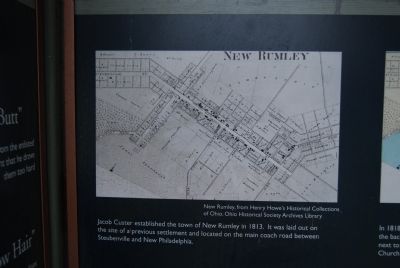
Photographed By Mike Wintermantel, December 21, 2014
13. Custer Monument - Interpretive Display
Panel 4 - caption 1
New Rumley, from Henry Howe's Historical Collections of Ohio. Ohio Historical Society Archives Library.
Jacob Custer established the town of New Rumley in 1813. It was laid out on a site of a previous settlement and located on the main coach road between Steubenville and New Philadelphia.
New Rumley, from Henry Howe's Historical Collections of Ohio. Ohio Historical Society Archives Library.
Jacob Custer established the town of New Rumley in 1813. It was laid out on a site of a previous settlement and located on the main coach road between Steubenville and New Philadelphia.
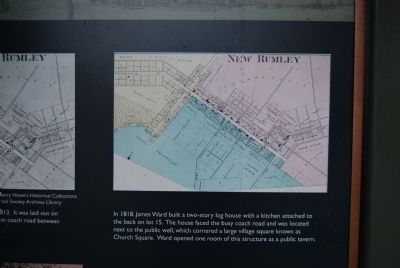
Photographed By Mike Wintermantel, December 21, 2014
14. Custer Monument - Interpretive Display
Panel 4 - caption 2
In 1818, James Ward built a two-story log house with a kitchen attached to the back on lot 15. The house faced the busy coach road and was located next to the public well, which cornered a large village square known as Church Square. Ward opened one room of this structure as a public tavern.
In 1818, James Ward built a two-story log house with a kitchen attached to the back on lot 15. The house faced the busy coach road and was located next to the public well, which cornered a large village square known as Church Square. Ward opened one room of this structure as a public tavern.
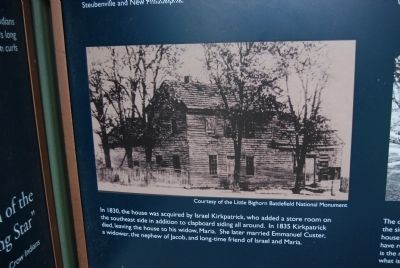
Photographed By Mike Wintermantel, December 21, 2014
15. Custer Monument - Interpretive Display
Panel 4 - caption 3
Courtesy of Little Bighorn Battlefield National Monument
In 1830, the house was acquired by Israel Kirkpatrick, who added a store room on the southeast side in addition to clapboard siding all around. In 1835 Kirkpatrick died, leaving the house to his widow, Maria. She later married Emmanuel Custer, a widower, the nephew of Jacob, and long-time friend of Israel and Maria.
Courtesy of Little Bighorn Battlefield National Monument
In 1830, the house was acquired by Israel Kirkpatrick, who added a store room on the southeast side in addition to clapboard siding all around. In 1835 Kirkpatrick died, leaving the house to his widow, Maria. She later married Emmanuel Custer, a widower, the nephew of Jacob, and long-time friend of Israel and Maria.
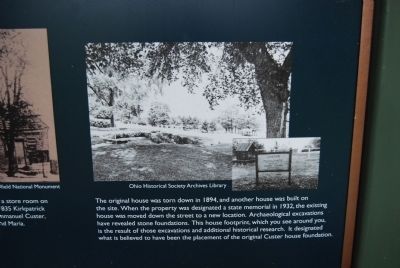
Photographed By Mike Wintermantel, December 21, 2014
16. Custer Monument - Interpretive Display
Panel 4 - caption 4
Ohio Historical Society Archives Library.
The original house was torn down in 1894, and another house was built on the site. When the property was designated a state memorial in 1932, the existing house was moved down the street to a new location. Archaological excavations have revealed stone foundations. This house footprint, which you see around you, is the result of those excavations and additional historical research. It designated what is believed to have been the placement of the original Custer house foundation.
Ohio Historical Society Archives Library.
The original house was torn down in 1894, and another house was built on the site. When the property was designated a state memorial in 1932, the existing house was moved down the street to a new location. Archaological excavations have revealed stone foundations. This house footprint, which you see around you, is the result of those excavations and additional historical research. It designated what is believed to have been the placement of the original Custer house foundation.
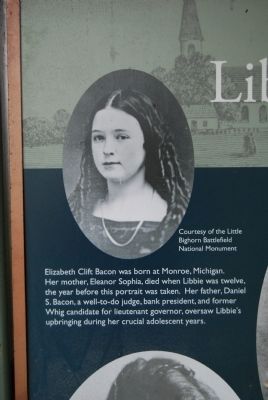
Photographed By Mike Wintermantel, December 21, 2014
18. Custer Monument - Interpretive Display
Panel 5 - caption 1
Courtesy of the Little Bighorn Battlefield National Monument
Elizabeth Clift Bacon was born at Monroe, Michigan. Her mother, Eleanor Sophia, died when Libbie was twelve, the year before this portrait was taken. Her father, Daniel S. Bacon, a well-to-do judge, bank president, and former Whig candidate for lieutenant governor, oversaw Libbie's upbringing during her crucial adolescent years.
Courtesy of the Little Bighorn Battlefield National Monument
Elizabeth Clift Bacon was born at Monroe, Michigan. Her mother, Eleanor Sophia, died when Libbie was twelve, the year before this portrait was taken. Her father, Daniel S. Bacon, a well-to-do judge, bank president, and former Whig candidate for lieutenant governor, oversaw Libbie's upbringing during her crucial adolescent years.
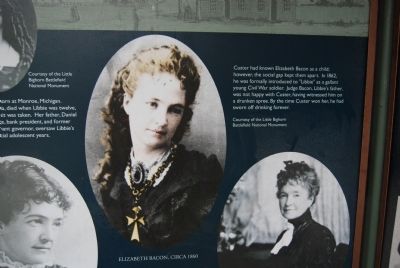
Photographed By Mike Wintermantel, December 21, 2014
19. Custer Monument - Interpretive Display
Panel 5 - caption 2
Courtesy of the Little Bighorn Battlefield National Monument
Custer had known Elizabeth Bacon as a child; however, the social gap kept them apart. in 1862, he was formally introduced to "Libbie" as a gallant young Civil War soldier. Judge Bacon, Libbie's father, was not happy with Custer, having witnessed him on a drunken spree. By the time Custer won her, he had sworn off drinking forever.
Courtesy of the Little Bighorn Battlefield National Monument
Custer had known Elizabeth Bacon as a child; however, the social gap kept them apart. in 1862, he was formally introduced to "Libbie" as a gallant young Civil War soldier. Judge Bacon, Libbie's father, was not happy with Custer, having witnessed him on a drunken spree. By the time Custer won her, he had sworn off drinking forever.
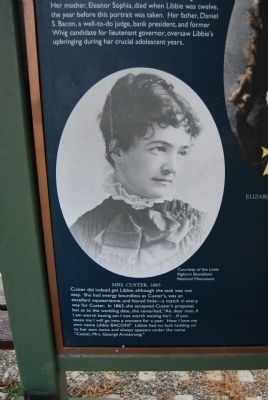
Photographed By Mike Wintermantel, December 21, 2014
20. Custer Monument -Interpretive Display
Panel 5 - caption 3
Courtesy of the Little Bighorn Battlefield National Monument
Mrs. Custer, 1885
Custer did indeed get Libbie, although the task was not easy. She had energy boundless as Custer's, was an excellent equestrienne, and feared little - a match in every way for Custer. In 1863, she accepted Custer's proposal, but as to the wedding date, she remarked, "Ah, dear man, if I am worth having am I not worth waiting for?...If you tease me I will go into a convent for a year. How I love my own name Libbie BACON!" Libbie had no luck holding on to her own name and always appears under the name "Custer, Mrs. George Armstrong."
Courtesy of the Little Bighorn Battlefield National Monument
Mrs. Custer, 1885
Custer did indeed get Libbie, although the task was not easy. She had energy boundless as Custer's, was an excellent equestrienne, and feared little - a match in every way for Custer. In 1863, she accepted Custer's proposal, but as to the wedding date, she remarked, "Ah, dear man, if I am worth having am I not worth waiting for?...If you tease me I will go into a convent for a year. How I love my own name Libbie BACON!" Libbie had no luck holding on to her own name and always appears under the name "Custer, Mrs. George Armstrong."

Photographed By Mike Wintermantel, December 21, 2014
21. Custer Monument - Interpretive Display
Panel 5 - caption 4
Courtesy of the Little Bighorn Battlefield National Monument
Mrs. Custer, 1900
Married on February 9, 1864, at the First Presbyterian Church in Monroe, Michigan, Libbie remained a constant and close supporter of her husband throughout their married life. Through 57 years of widowhood, Libbie defended her Autie's reputation. In 1908, at age 67, she toured Europe, and young women still noticed, with jealous eyes, that gentlemen turned their heads and vied for her company when she entered a room. Death came on April 6, 1933, and she was laid to rest by the side of the general at West Point.
Courtesy of the Little Bighorn Battlefield National Monument
Mrs. Custer, 1900
Married on February 9, 1864, at the First Presbyterian Church in Monroe, Michigan, Libbie remained a constant and close supporter of her husband throughout their married life. Through 57 years of widowhood, Libbie defended her Autie's reputation. In 1908, at age 67, she toured Europe, and young women still noticed, with jealous eyes, that gentlemen turned their heads and vied for her company when she entered a room. Death came on April 6, 1933, and she was laid to rest by the side of the general at West Point.
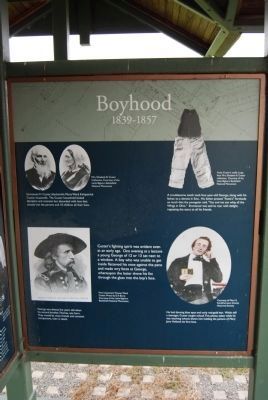
Photographed By Mike Wintermantel, December 21, 2014
22. Custer Monument - Interpretive Display
Panel 6
Boyhood 1839-1857
Custer's fighting spirit was evident even at an early age. One evening at a lecture a young George of 12 or 13 sat next to a window. A boy who was unable to get inside flattened his nose against the pane and made wry faces at George, whereupon the latter drove his fist through the glass and into the boy's face.
Boyhood 1839-1857
Custer's fighting spirit was evident even at an early age. One evening at a lecture a young George of 12 or 13 sat next to a window. A boy who was unable to get inside flattened his nose against the pane and made wry faces at George, whereupon the latter drove his fist through the glass and into the boy's face.
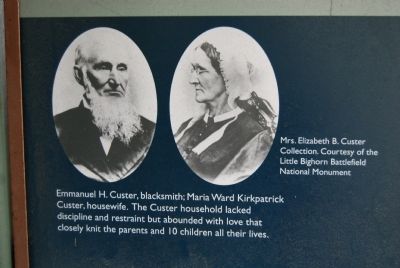
Photographed By Mike Wintermantel, December 21, 2014
23. Custer Monument - Interpretive Display
Panel 6 - caption 1
Mrs. Elizabeth B. Custer Collection. Courtesy of the Little Bighorn Battlefield National Monument
Emmanuel H. Custer, blacksmith; Maria Ward Kirkpatrick Custer, housewife. The Custer household lacked discipline and restraint but abounded with love that closely knit the parents and 10 children all their lives.
Mrs. Elizabeth B. Custer Collection. Courtesy of the Little Bighorn Battlefield National Monument
Emmanuel H. Custer, blacksmith; Maria Ward Kirkpatrick Custer, housewife. The Custer household lacked discipline and restraint but abounded with love that closely knit the parents and 10 children all their lives.
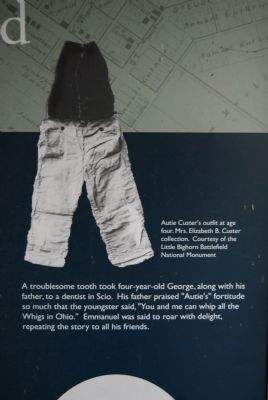
Photographed By Mike Wintermantel, December 21, 2014
24. Custer Monument - Interpretive Display
Panel 6 - caption 2
Autie Custer's outfit at age four. Mrs. Elizabeth B. Custer Collection. Courtesy of the Little Bighorn Battlefield National Monument
A troublesome tooth took four-year-old George, along with his father, to a dentist in Scio. His father praised "Autie's" fortitude so much that the youngster said, "You and me can whip all the Whigs in Ohio." Emmanuel was said to roar with delight, repeating the story to all his friends.
Autie Custer's outfit at age four. Mrs. Elizabeth B. Custer Collection. Courtesy of the Little Bighorn Battlefield National Monument
A troublesome tooth took four-year-old George, along with his father, to a dentist in Scio. His father praised "Autie's" fortitude so much that the youngster said, "You and me can whip all the Whigs in Ohio." Emmanuel was said to roar with delight, repeating the story to all his friends.
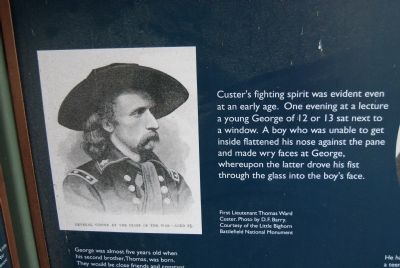
Photographed By Mike Wintermantel, December 21, 2014
25. Custer Monument - Interpretive Display
Panel 6 - caption 3
First Lieutenant Thomas Ward Custer. Photo by D.F. Barry. Courtesy of the Little Bighorn Battlefield National Monument
George was almost five years old when his second brother, Thomas was born. They would be close friends and constant companions even in death.
First Lieutenant Thomas Ward Custer. Photo by D.F. Barry. Courtesy of the Little Bighorn Battlefield National Monument
George was almost five years old when his second brother, Thomas was born. They would be close friends and constant companions even in death.
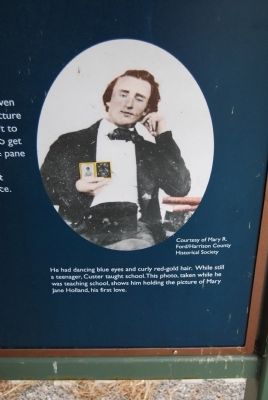
Photographed By Mike Wintermantel, December 21, 2014
26. Custer Monument - Interpretive Display
Panel 6 - caption 4
Courtesy of Mary R. Ford/Harrison County Historical Society
He had dancing blue eyes and curly red-gold hair. While still a teenager, Custer taught school. This photo, taken while he was teaching school, shows him holding the picture of Mary Jane Holland, his first love.
Courtesy of Mary R. Ford/Harrison County Historical Society
He had dancing blue eyes and curly red-gold hair. While still a teenager, Custer taught school. This photo, taken while he was teaching school, shows him holding the picture of Mary Jane Holland, his first love.
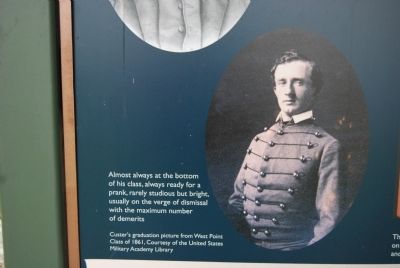
Photographed By Mike Wintermantel, December 21, 2014
30. Custer Monument - Interpretive Display
Panel 7 - caption 3
Always at the bottom of his class, always ready for a prank, rarely studious but bright, usually on the verge of dismissal with the maximum number of demerits.
Custer's graduation picture from West Point Class of 1861, Courtesy of the United States Military Academy Library.
Always at the bottom of his class, always ready for a prank, rarely studious but bright, usually on the verge of dismissal with the maximum number of demerits.
Custer's graduation picture from West Point Class of 1861, Courtesy of the United States Military Academy Library.
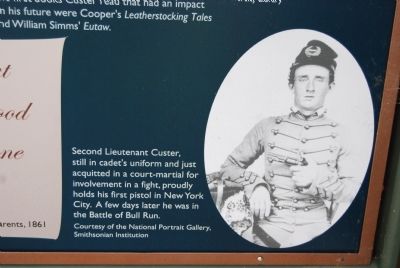
Photographed By Mike Wintermantel, December 21, 2014
31. Custer Monument - Interpretive Display
Panel 7 - caption 4
Second Lieutenant Custer, still in cadet's uniform and just acquitted in a court-martial for involvement in a fight, proudly holds his first pistol in New York City. A few days later he was in the Battle of Bull Run.
Courtesy of the National Portrait Gallery, Smithsonian Institution
Second Lieutenant Custer, still in cadet's uniform and just acquitted in a court-martial for involvement in a fight, proudly holds his first pistol in New York City. A few days later he was in the Battle of Bull Run.
Courtesy of the National Portrait Gallery, Smithsonian Institution
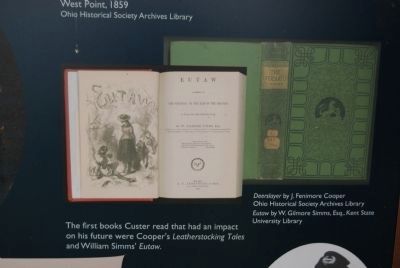
Photographed By Mike Wintermantel, December 21, 2014
32. Custer Monument - Interpretive Display
Panel 7 - caption 5
The first books Custer read that had an impact on his future were Cooper's Leatherstocking Tales and William Simms' Eutaw
Deerslayer by J. Fenimore Cooper
Ohio Historical Society Archives Library
Eutaw by W. Gilmore Simms, Esq., Kent State University Library
The first books Custer read that had an impact on his future were Cooper's Leatherstocking Tales and William Simms' Eutaw
Deerslayer by J. Fenimore Cooper
Ohio Historical Society Archives Library
Eutaw by W. Gilmore Simms, Esq., Kent State University Library
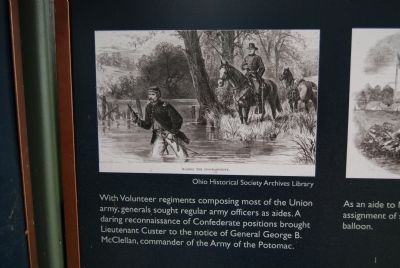
Photographed By Mike Wintermantel, December 21, 2014
34. Custer Monument - Interpretive Display
Panel 8 - caption 1
With Volunteer regiments composing most of the Union army, generals, sought regular army officers as aides. A daring reconnaissance of Confederate positions brought Lieutenant Custer to the notice of General George B. McClellan, commander of the Army of the Potomac.
Ohio Historical Society Archives Library
With Volunteer regiments composing most of the Union army, generals, sought regular army officers as aides. A daring reconnaissance of Confederate positions brought Lieutenant Custer to the notice of General George B. McClellan, commander of the Army of the Potomac.
Ohio Historical Society Archives Library
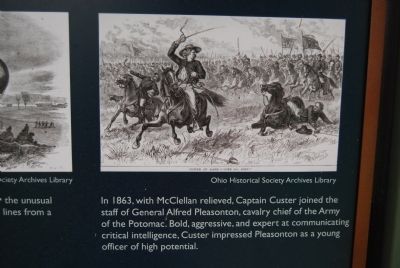
Photographed By Mike Wintermantel, December 21, 2014
36. Custer Monument - Interpretive Display
Panel 8 - caption 3
In 1863, with McClellan relieved, Captain Custer joined the staff of General Alfred Pleasonton, cavalry chief of the Army of the Potomac. Bold, aggressive, and expert at communicating critical intelligence, Custer impressed Pleasanton as a young officer of high potential.
Ohio Historical Society Archives Library
In 1863, with McClellan relieved, Captain Custer joined the staff of General Alfred Pleasonton, cavalry chief of the Army of the Potomac. Bold, aggressive, and expert at communicating critical intelligence, Custer impressed Pleasanton as a young officer of high potential.
Ohio Historical Society Archives Library
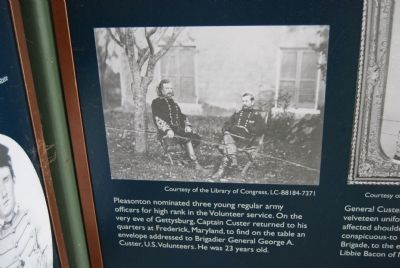
Photographed By Mike Wintermantel, December 21, 2014
37. Custer Monument -Interpretive Display
Panel 8 - caption 4
Pleasanton nominated three young regular army officers for high rank in the Volunteer service. On the very eve of Gettysburg, Captain Custer returned to his quarters at Frederick, Maryland, to find on the table an envelope addressed to Brigadier General George A. Custer, U.S. Volunteers. He was 23 years old.
Courtesy of the Library of Congress, LC-B8184-7371
Pleasanton nominated three young regular army officers for high rank in the Volunteer service. On the very eve of Gettysburg, Captain Custer returned to his quarters at Frederick, Maryland, to find on the table an envelope addressed to Brigadier General George A. Custer, U.S. Volunteers. He was 23 years old.
Courtesy of the Library of Congress, LC-B8184-7371
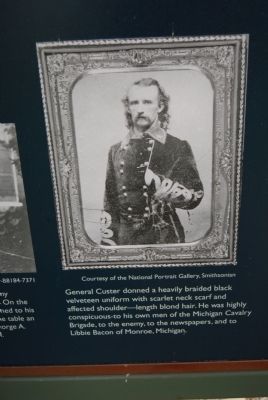
Photographed By Mike Wintermantel, December 21, 2014
38. Custer Monument - Interpretive Display
Panel 8 - caption 5
General Custer donned a heavy braided black velveteen uniform with scarlet neck scarf and affected shoulder - length blond hair. He was highly conspicuous-to his own men of the Michigan Cavalry Brigade, to the enemy, to the newspapers, and to Libbie Bacon of Monroe, Michigan.
Courtesy of the National Portrait Gallery, Smithsonian
General Custer donned a heavy braided black velveteen uniform with scarlet neck scarf and affected shoulder - length blond hair. He was highly conspicuous-to his own men of the Michigan Cavalry Brigade, to the enemy, to the newspapers, and to Libbie Bacon of Monroe, Michigan.
Courtesy of the National Portrait Gallery, Smithsonian
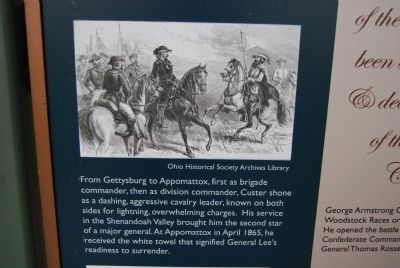
Photographed By Mike Wintermantel, December 21, 2014
42. Custer Monument - Interpretive Display
Panel 9 - caption 2
From Gettysburg to Appomattox, first as brigade commander, then as division commander, Custer shone as a dashing, aggressive cavalry leader, known on both side for lightning, overwhelming charges. His service in the Shenandoah Valley brought him the second star of a major general. At Appomattox in April 1865, he received the white towel that signified General Lee's readiness to surrender.
Ohio Historical Society Archives Library
From Gettysburg to Appomattox, first as brigade commander, then as division commander, Custer shone as a dashing, aggressive cavalry leader, known on both side for lightning, overwhelming charges. His service in the Shenandoah Valley brought him the second star of a major general. At Appomattox in April 1865, he received the white towel that signified General Lee's readiness to surrender.
Ohio Historical Society Archives Library
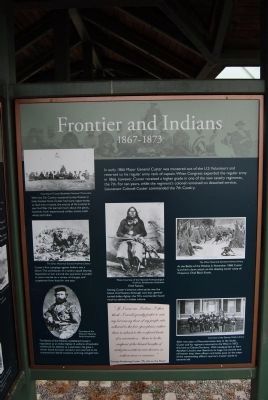
Photographed By Mike Wintermantel, December 21, 2014
47. Custer Monument - Interpretive Display
Panel 10
Frontier and Indians
1867-1873
In early 1866 Major General Custer was mustered out of the U.S. Volunteers and reverted to his regular army rank of captain. When Congress expanded the regular army in 1866, however, Custer received a higher grade in one of the new cavalry regiments, the 7th. For ten years, while the regiments colonel remained on detached service, Lieutenant Colonel Custer commanded the 7th Cavalry.
Frontier and Indians
1867-1873
In early 1866 Major General Custer was mustered out of the U.S. Volunteers and reverted to his regular army rank of captain. When Congress expanded the regular army in 1866, however, Custer received a higher grade in one of the new cavalry regiments, the 7th. For ten years, while the regiments colonel remained on detached service, Lieutenant Colonel Custer commanded the 7th Cavalry.
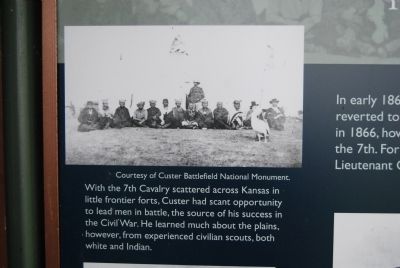
Photographed By Mike Wintermantel, December 21, 2014
48. Custer Monument - Interpretive Display
Panel 10 - caption 1
With the 7th Cavalry scattered across Kansas in little frontier forts, Custer had scant opportunity to lead men in battle, the source of his success in the Civil War. He learned much about the plains, however, from experienced civilian scouts, both white and Indian.
Courtesy of Custer Battlefield National Monument
With the 7th Cavalry scattered across Kansas in little frontier forts, Custer had scant opportunity to lead men in battle, the source of his success in the Civil War. He learned much about the plains, however, from experienced civilian scouts, both white and Indian.
Courtesy of Custer Battlefield National Monument
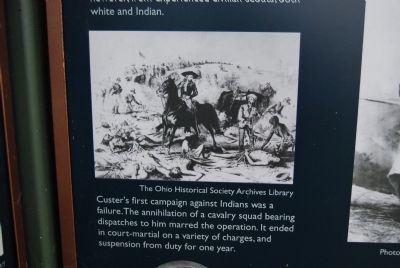
Photographed By Mike Wintermantel, December 21, 2014
49. Custer Monument - Interpretive Display
Panel 10 - caption 2
Custer's first campaign against the Indians was a failure. The annihilation of a cavalry squad bearing dispatches to him marred the operation. It ended in court-martial on a variety of charges, and suspension from duty for one year.
The Ohio Historical Society Archives Library
Custer's first campaign against the Indians was a failure. The annihilation of a cavalry squad bearing dispatches to him marred the operation. It ended in court-martial on a variety of charges, and suspension from duty for one year.
The Ohio Historical Society Archives Library

Photographed By Mike Wintermantel, December 21, 2014
50. Custer Monument - Interpretive Display
Panel 10 - caption 3
The Battle of the Washita established Custer's reputation as an Indian fighter. A uniform of buckskin reinforced his identity as a plainsman. He grew a winter beard but later shaved it and returned to his characteristic blond mustache and long red-gold hair.
Courtesy of the Western National Parks Association
The Battle of the Washita established Custer's reputation as an Indian fighter. A uniform of buckskin reinforced his identity as a plainsman. He grew a winter beard but later shaved it and returned to his characteristic blond mustache and long red-gold hair.
Courtesy of the Western National Parks Association
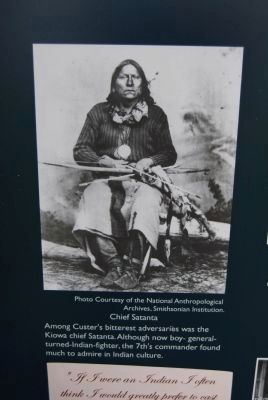
Photographed By Mike Wintermantel, December 21, 2014
51. Custer Monument - Interpretive Display
Panel 10 - caption 4
Chief Satanta
Among Custer's bitterest adversaries was the Kiowa chief Satanta. Although now boy-general-turned-Indian-fighter, the 7th's commander found much to admire in Indian culture.
Photo Courtesy of the National Anthropological Archives, Smithsonian Institution
Chief Satanta
Among Custer's bitterest adversaries was the Kiowa chief Satanta. Although now boy-general-turned-Indian-fighter, the 7th's commander found much to admire in Indian culture.
Photo Courtesy of the National Anthropological Archives, Smithsonian Institution
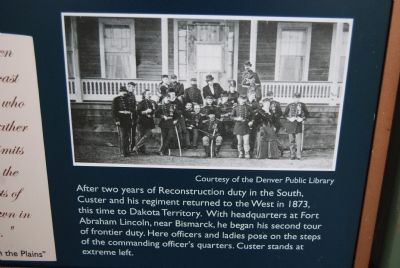
Photographed By Mike Wintermantel, December 21, 2014
53. Custer Monument - Interpretive Display
Panel 10 - caption 6
After two years of Reconstruction duty in the South, Custer and his regiment returned to the West in 1873, this time the Dakota Territory. With headquarters at Fort Abraham Lincoln, near Bismarck, he began his second tour of frontier duty. Here officers and ladies pose on the steps of the commanding officer's quarters. Custer stands at extreme left.
Courtesy of the Denver Public Library
After two years of Reconstruction duty in the South, Custer and his regiment returned to the West in 1873, this time the Dakota Territory. With headquarters at Fort Abraham Lincoln, near Bismarck, he began his second tour of frontier duty. Here officers and ladies pose on the steps of the commanding officer's quarters. Custer stands at extreme left.
Courtesy of the Denver Public Library
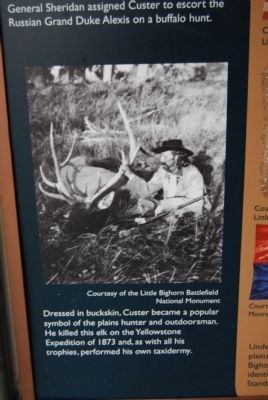
Photographed By Mike Wintermantel, December 21, 2014
56. Custer Monument - Interpretive Display
Panel 11 - caption 2
Dressed in buckskin, Custer became a popular symbol of the plains hunter and outdoorsman. He killed this elk on the Yellowstone Expedition of 1873 and, with all his trophies, performed his own taxidermy.
Courtesy of the Little Bighorn Battlefield National Monument
Dressed in buckskin, Custer became a popular symbol of the plains hunter and outdoorsman. He killed this elk on the Yellowstone Expedition of 1873 and, with all his trophies, performed his own taxidermy.
Courtesy of the Little Bighorn Battlefield National Monument
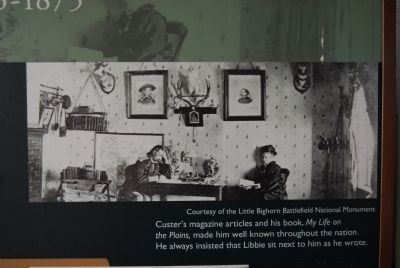
Photographed By Mike Wintermantel, December 21, 2014
57. Custer Monument - Interpretive Display
Panel 11 - caption 3
Custer's magazine articles and his book, My Life on the Plains, made him well known throughout the nation. He always insisted Libbie sit next to him as he wrote.
Courtesy of the Little Bighorn Battlefield National Monument
Custer's magazine articles and his book, My Life on the Plains, made him well known throughout the nation. He always insisted Libbie sit next to him as he wrote.
Courtesy of the Little Bighorn Battlefield National Monument
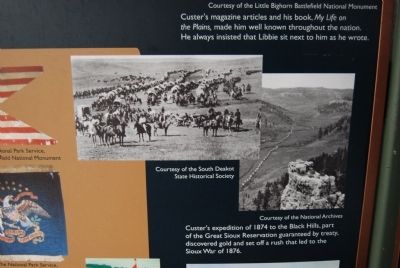
Photographed By Mike Wintermantel, December 21, 2014
58. Custer Monument - Interpretive Display
Panel 11 - caption 4
Custer's expedition of 1874 to the Black Hills, part of the Great Sioux Reservation guaranteed by treaty, discovered gold and set off a rush that led to the Sioux War of 1876.
(left photo)Courtesy of the South Deakot State Historical Society
(right photo) Courtesy of the National Archives
Custer's expedition of 1874 to the Black Hills, part of the Great Sioux Reservation guaranteed by treaty, discovered gold and set off a rush that led to the Sioux War of 1876.
(left photo)Courtesy of the South Deakot State Historical Society
(right photo) Courtesy of the National Archives
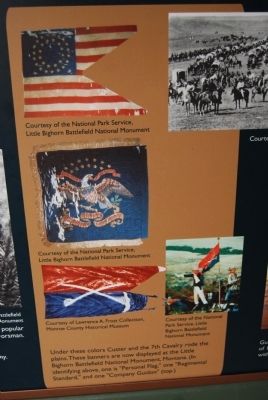
Photographed By Mike Wintermantel, December 21, 2014
60. Custer Monument - Interpretive Display
Panel 11 - caption 6
Under these colors Custer and the 7th Cavalry rode the plains. These banners are now displayed at the Little Bighorn Battlefield National Monument, Montana. (In identifying above, one is "Personal Flag," one "Regimental Standard," and one "Company Guidon" (top.)
Under these colors Custer and the 7th Cavalry rode the plains. These banners are now displayed at the Little Bighorn Battlefield National Monument, Montana. (In identifying above, one is "Personal Flag," one "Regimental Standard," and one "Company Guidon" (top.)

Photographed By Mike Wintermantel, December 21, 2014
62. Custer Monument - Interpretive Display
Panel 12 - caption 1
General Crook fought two unsuccessful battles, Colonel Gibbon none. On June 22 General Terry launched Custer and the 7th Cavalry from the Yellowstone River south to find and defeat the Indians. The regiment numbered about six hundred, with rations and ammunition carried on pack mules.
Courtesy of Mark Churms
General Crook fought two unsuccessful battles, Colonel Gibbon none. On June 22 General Terry launched Custer and the 7th Cavalry from the Yellowstone River south to find and defeat the Indians. The regiment numbered about six hundred, with rations and ammunition carried on pack mules.
Courtesy of Mark Churms
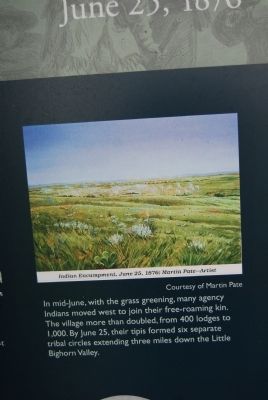
Photographed By Mike Wintermantel, December 21, 2014
63. Custer Monument - Interpretive Display
Panel 12 - caption 2
In mid-June with the grass greening, many agency Indians moved west to join their free-roaming kin. The village more than doubled, from 400 lodge to 1,000. By June 25, their tipis formed six separate tribal circles extending three miles down the Little Bighorn Valley.
Courtesy of the Martin Pate
In mid-June with the grass greening, many agency Indians moved west to join their free-roaming kin. The village more than doubled, from 400 lodge to 1,000. By June 25, their tipis formed six separate tribal circles extending three miles down the Little Bighorn Valley.
Courtesy of the Martin Pate
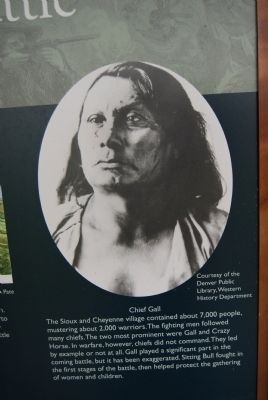
Photographed By Mike Wintermantel, December 21, 2014
64. Custer Monument - Interpretive Display
Panel 12 - caption 3
Chief Gall
The Sioux and Cheyenne village contained about 7,000 people, mustering about 2,000 warriors. The fighting men followed many chiefs. The two most prominent were Gall and Crazy Horse. In warfare, however, chiefs did not command. They led by example or not at all. Gall played a significant part in the coming battle, but it has been exaggerated. Sitting Bull fought in the first stages of the battle, then helped protect the gathering of women and children.
Courtesy of the Denver Public Library, Western History Department
Chief Gall
The Sioux and Cheyenne village contained about 7,000 people, mustering about 2,000 warriors. The fighting men followed many chiefs. The two most prominent were Gall and Crazy Horse. In warfare, however, chiefs did not command. They led by example or not at all. Gall played a significant part in the coming battle, but it has been exaggerated. Sitting Bull fought in the first stages of the battle, then helped protect the gathering of women and children.
Courtesy of the Denver Public Library, Western History Department

Photographed By Mike Wintermantel, December 21, 2014
65. Custer Monument - Interpretive Display
Panel 12 - caption 4
Captain Frederick W. Benteen
Major Marcus A. Reno
On June 25, 1876, Custer divided the 7th Cavalry and attacked the Indian village. The role of his two principal subordiantes is controversial. Some blame them for what happened to Custer. Others blame Custer himself.
(Benteen photo) Courtesy of the National Anthropological Archives, Smithsonian Institution
(Reno photo) Denver Public Library, Western History Department
Captain Frederick W. Benteen
Major Marcus A. Reno
On June 25, 1876, Custer divided the 7th Cavalry and attacked the Indian village. The role of his two principal subordiantes is controversial. Some blame them for what happened to Custer. Others blame Custer himself.
(Benteen photo) Courtesy of the National Anthropological Archives, Smithsonian Institution
(Reno photo) Denver Public Library, Western History Department

Photographed By Mike Wintermantel, December 21, 2014
66. Custer Monument - Interpretive Display
Panel 12 - caption 5
While Benteen joined Reno's bloodied command four miles to the south, the warriors concentrated against Custer and the five companies under his immediate command, about 210 men. Not one survived. The most famous of the hundreds of depictions of Custer's Last Stand is the lithograph that hung in countless saloons. It contains many inaccuracies, but it is the one the public knows best.
Courtesy of the Denver Public Library, Western History Department
While Benteen joined Reno's bloodied command four miles to the south, the warriors concentrated against Custer and the five companies under his immediate command, about 210 men. Not one survived. The most famous of the hundreds of depictions of Custer's Last Stand is the lithograph that hung in countless saloons. It contains many inaccuracies, but it is the one the public knows best.
Courtesy of the Denver Public Library, Western History Department
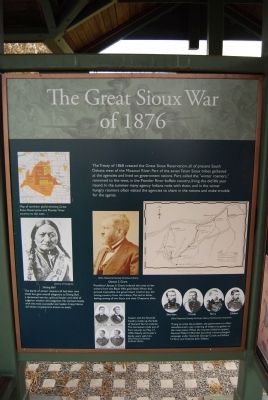
Photographed By Mike Wintermantel, December 21, 2014
67. Custer Monument - Interpretive Display
Panel 13
The Great Sioux War of 1876
The Treaty of 1868 created the Great Sioux Reservation, all of present South Dakota west of the Missouri River. Part of the seven Teton Sioux tribes gathered at the agencies and lived on government rations. Part, called the "winter roamers," remained to the west, in the Powder River buffalo country, living the old life year round. In the summer many agency Indians rode with them, and in the winter hungry roamers often visited the agencies to share in the rations and make trouble for the agents.
The Great Sioux War of 1876
The Treaty of 1868 created the Great Sioux Reservation, all of present South Dakota west of the Missouri River. Part of the seven Teton Sioux tribes gathered at the agencies and lived on government rations. Part, called the "winter roamers," remained to the west, in the Powder River buffalo country, living the old life year round. In the summer many agency Indians rode with them, and in the winter hungry roamers often visited the agencies to share in the rations and make trouble for the agents.
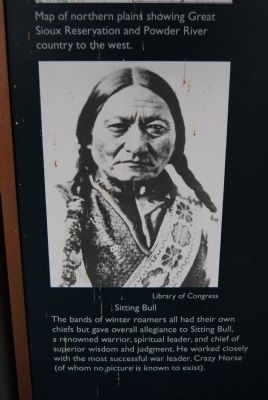
Photographed By Mike Wintermantel, December 21, 2014
69. Custer Monument - Interpretive Display
Panel 13 - caption 2
Sitting Bull
The bands of winter roamers all had their own chiefs but gave overall allegiance to Sitting Bull, a renowned warrior, spiritual leader, and chief of superior wisdom and judgment. He worked closely with the most successful war leader, Crazy Horse (of whom no picture is known to exist).
Library of Congress
Sitting Bull
The bands of winter roamers all had their own chiefs but gave overall allegiance to Sitting Bull, a renowned warrior, spiritual leader, and chief of superior wisdom and judgment. He worked closely with the most successful war leader, Crazy Horse (of whom no picture is known to exist).
Library of Congress

Photographed By Mike Wintermantel, December 21, 2014
70. Custer Monument - Interpretive Display
Panel 13 - caption 3
Ulysses S. Grant
President Ulysses S. Grant ordered the army to bar miners from the Black Hills gold fields. When that proved impossible, the government tried to buy the mining country from the Indians. This led to bitter feeling among all the Sioux and their Cheyenne allies.
Ohio Historical Society Archives Library
Ulysses S. Grant
President Ulysses S. Grant ordered the army to bar miners from the Black Hills gold fields. When that proved impossible, the government tried to buy the mining country from the Indians. This led to bitter feeling among all the Sioux and their Cheyenne allies.
Ohio Historical Society Archives Library
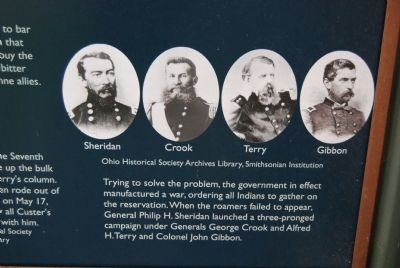
Photographed By Mike Wintermantel, December 21, 2014
71. Custer Monument - Interpretive Display
Panel 13 - caption 4
Sheridan Crook Terry Gibbon
Trying to solve the problem, the government in effect manufactured a war, ordering all Indians to gather on the reservation. When the roamers failed to appear, General Philip H. Sheridan launched a three-pronged campaign under Generals George Crook and Alfred H. Terry and Colonel John Gibbon.
Ohio Historical Society Archives Library, Smithsonian Institution
Sheridan Crook Terry Gibbon
Trying to solve the problem, the government in effect manufactured a war, ordering all Indians to gather on the reservation. When the roamers failed to appear, General Philip H. Sheridan launched a three-pronged campaign under Generals George Crook and Alfred H. Terry and Colonel John Gibbon.
Ohio Historical Society Archives Library, Smithsonian Institution
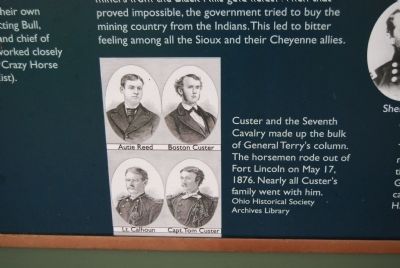
Photographed By Mike Wintermantel, December 21, 2014
72. Custer Monument - Interpretive Display
Panel 13 - caption 5
Autie Reed Boston Custer Lt. Calhoun Capt. Tom Custer
Custer and the Seventh Cavalry made up the bulk of General Terry's column. The horsemen rode out of Fort Lincoln on May 17, 1876. Nearly all Custer's family went with him.
Ohio Historical Society Archives Library
Autie Reed Boston Custer Lt. Calhoun Capt. Tom Custer
Custer and the Seventh Cavalry made up the bulk of General Terry's column. The horsemen rode out of Fort Lincoln on May 17, 1876. Nearly all Custer's family went with him.
Ohio Historical Society Archives Library
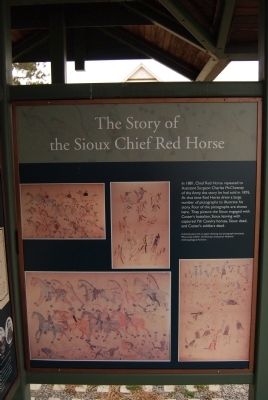
Photographed By Mike Wintermantel, December 21, 2014
73. Custer Monument - Interpretive Display
Panel 14
The Story of the Sioux Chief Red Horse
In 1881, Chief Red Horse repeated to Assistant Surgeon Charles McChesney of the Army the story he had told in 1876. At that time Red Horse drew a large number of pictographs to illustrate his story. Four of the pictographs are shown here. They picture the Sioux engaged with Custer's battalion, Sioux leaving with captured 7th Cavalry horses, Sioux dead, and Custer's soldiers dead.
Colored pencil ink on paper drawing and pictograph laminated. Manuscript 2367A, Smithsonian Institution National Anthropoligical Archives
The Story of the Sioux Chief Red Horse
In 1881, Chief Red Horse repeated to Assistant Surgeon Charles McChesney of the Army the story he had told in 1876. At that time Red Horse drew a large number of pictographs to illustrate his story. Four of the pictographs are shown here. They picture the Sioux engaged with Custer's battalion, Sioux leaving with captured 7th Cavalry horses, Sioux dead, and Custer's soldiers dead.
Colored pencil ink on paper drawing and pictograph laminated. Manuscript 2367A, Smithsonian Institution National Anthropoligical Archives
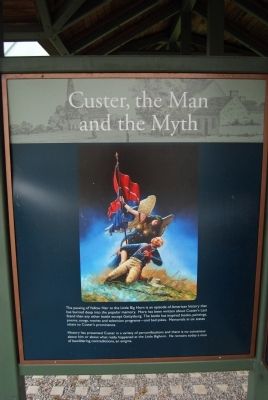
Photographed By Mike Wintermantel, December 21, 2014
78. Custer Monument - Interpretive Display
Panel 15
Custer, the Man and the Myth
The passing of Yellow Hair at the Little Big Horn is an episode of American history that has burned deep into the popular memory. More has been written about Custer's Last Stand than any other battle except Gettysburg. The battle has inspired books, paintings, poems, songs, movies and television programs - and bad jokes. Memorials in six states attest to Custer's prominence.
History has presented Custer in a variety of personifications and there is no consensus about him or about what really happened at the Little Bighorn. He remains today a man of bewildering contradictions, an enigma.
Custer, the Man and the Myth
The passing of Yellow Hair at the Little Big Horn is an episode of American history that has burned deep into the popular memory. More has been written about Custer's Last Stand than any other battle except Gettysburg. The battle has inspired books, paintings, poems, songs, movies and television programs - and bad jokes. Memorials in six states attest to Custer's prominence.
History has presented Custer in a variety of personifications and there is no consensus about him or about what really happened at the Little Bighorn. He remains today a man of bewildering contradictions, an enigma.
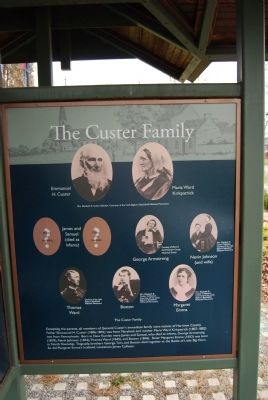
Photographed By Mike Wintermantel, December 21, 2014
79. Custer Monument - Interpretive Display
Panel 16
The Custer Family
Excepting the parents, all members of General Custer's immediate family were natives of Harrison County.
Father Emmanuel H. Custer (1806-1892) was from Maryland, and mother Maria Ward Kirkpatrick (1807-1882) was from Pennsylvania. Born in New Rumley were James and Samuel, who died as infants, George Armstrong (1839), Nevin Johnson (1842), Thomas Ward (1845), and Boston (1846). Sister Margaret Emma (1852) was born in North Township. Tragically, brothers George, Tom, and Boston died together at the Battle of Little Big Horn. So did Margaret Emma's husband, Lieutenant James Calhoun.
The Custer Family
Excepting the parents, all members of General Custer's immediate family were natives of Harrison County.
Father Emmanuel H. Custer (1806-1892) was from Maryland, and mother Maria Ward Kirkpatrick (1807-1882) was from Pennsylvania. Born in New Rumley were James and Samuel, who died as infants, George Armstrong (1839), Nevin Johnson (1842), Thomas Ward (1845), and Boston (1846). Sister Margaret Emma (1852) was born in North Township. Tragically, brothers George, Tom, and Boston died together at the Battle of Little Big Horn. So did Margaret Emma's husband, Lieutenant James Calhoun.
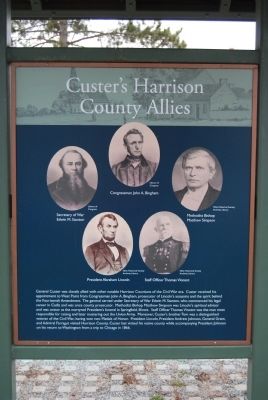
Photographed By Mike Wintermantel, December 21, 2014
82. Custer's Harrison County Allies
General Custer was closely allied with other notable Harrison Countians of the Civil War era. Custer received his appointment to West Point from Congressman John A. Bingham, prosecutor of Lincoln's assassins and the spirit behind the Fourteenth Amendment. The General served under Secretary of War Edwin M. Stanton, who commenced his legal career in Cadiz and was once county prosecutor. Methodist Bishop Matthew Simpson was Lincoln's spiritual advisor and was orator at the martyred President's funeral in Springfield, Illinois. Staff Officer Thomas Vincent was the man most responsible for raising and later mustering out the Union Army. Moreover, Custer's brother Tom was a distinguished veteran of the Civil War, having won two Medals of Honor. President Lincoln, President Andrew Johnson, General Grant, and Admiral Farragut visited Harrison County. Custer last visited his native county while accompanying President Johnson on his return to Washington from a trip to Chicago in 1866.
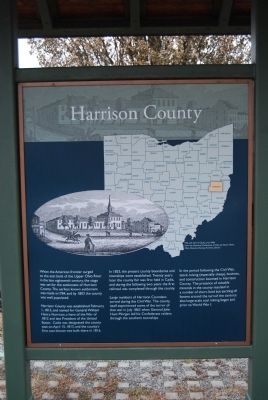
Photographed By Mike Wintermantel, December 21, 2014
84. Harrison County Panel
When the American frontier surged to the east bank of the Upper Ohio River in the late eighteenth century, the stage was set for the settlement of Harrison County. The earliest known settlement was made in 1784, and by 1803 the county was well populated.
Harrison County was established February 1, 1813, and named for General William Henry Harrison, a hero of the War of 1812 and late President of the United States. Cadiz was designated the county seat on April 15, 1813, and the county's first courthouse was built there in 1816.
In 1833, the present county boundaries and townships were established. Twenty years later the county fair was first held in Cadiz, and during the following two years the first railroad was completed through the county.
Large numbers of Harrison Countians served during the Civil War. The county itself experienced some terror of that war in July 1863 when General John Hunt Morgan led his Confederate raiders through the southern townships.
In the period following the Civil War, stock-raising (especially sheep), business, and construction boomed in Harrison County. The presence of valuable minerals in the county resulted in a number of short-lived but exciting oil booms around the turn of the century; also large-scale coal mining began just prior to World War I.
Harrison County was established February 1, 1813, and named for General William Henry Harrison, a hero of the War of 1812 and late President of the United States. Cadiz was designated the county seat on April 15, 1813, and the county's first courthouse was built there in 1816.
In 1833, the present county boundaries and townships were established. Twenty years later the county fair was first held in Cadiz, and during the following two years the first railroad was completed through the county.
Large numbers of Harrison Countians served during the Civil War. The county itself experienced some terror of that war in July 1863 when General John Hunt Morgan led his Confederate raiders through the southern townships.
In the period following the Civil War, stock-raising (especially sheep), business, and construction boomed in Harrison County. The presence of valuable minerals in the county resulted in a number of short-lived but exciting oil booms around the turn of the century; also large-scale coal mining began just prior to World War I.

Photographed By Mike Wintermantel, December 21, 2014
85. New Rumley Panel
New Rumley
The Village of New Rumley was platted August 16, 1813, by Jacob Custer, a granduncle of George Armstrong Custer. It was first a market town for the surrounding agricultural region and an important stop on the stage route between Steubenville and New Philadelphia. The village was long noted for its artisans such as gunsmith Alec Ager, and for its enterprise, when Harrison County's first bank opened here in 1814.
The Village of New Rumley was platted August 16, 1813, by Jacob Custer, a granduncle of George Armstrong Custer. It was first a market town for the surrounding agricultural region and an important stop on the stage route between Steubenville and New Philadelphia. The village was long noted for its artisans such as gunsmith Alec Ager, and for its enterprise, when Harrison County's first bank opened here in 1814.
Credits. This page was last revised on April 12, 2022. It was originally submitted on December 21, 2014, by Mike Wintermantel of Pittsburgh, Pennsylvania. This page has been viewed 1,487 times since then and 115 times this year. Photos: 1, 2, 3. submitted on December 21, 2014, by Mike Wintermantel of Pittsburgh, Pennsylvania. 4, 5, 6, 7, 8, 9, 10, 11, 12, 13, 14, 15, 16, 17, 18, 19, 20, 21, 22, 23, 24, 25, 26, 27, 28, 29, 30, 31, 32, 33, 34, 35, 36, 37, 38, 39, 40, 41, 42, 43, 44, 45, 46, 47, 48, 49, 50, 51, 52, 53, 54, 55, 56, 57, 58, 59, 60, 61, 62, 63, 64, 65, 66, 67, 68, 69, 70, 71, 72, 73, 74, 75, 76, 77, 78, 79, 80, 81, 82, 83, 84, 85. submitted on December 22, 2014, by Mike Wintermantel of Pittsburgh, Pennsylvania.
